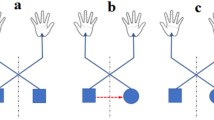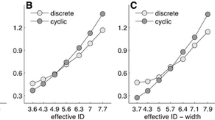Abstract
According to Fitts’ law, there is speed-accuracy trade-off in a wide variety of discrete aiming movements. However, it is unknown whether the same law applies to cyclic aiming movements. In the present study, a comparison is made between discrete versus cyclic aiming movements. A group of 24 healthy participants made graphical pen movements in 12 different aiming tasks in which successive finger and wrist movements were emphasized, consecutively executed as discrete and cyclic movements and varying in three target widths. In the cyclic condition, aiming movements consisted of back-and-forth movements that were performed in immediate succession for 20 s. In the discrete condition, back-and-forth aiming movements were drawn as 20 single strokes, starting after a go signal and stopping after reaching the target area. The targets had various levels of spatial accuracy and the movements had different directions (from lower left to upper right; from lower right to upper left) elicit either predominantly wrist or finger movements. The amount of information processed per unit of time (bits per second; index of performance, IP), tangential velocity, the pen pressure, and the ratio of peak-over-mean velocity were studied to gain understanding about the differences in control between discrete and cyclic movements. It was found that the IP and movement velocity were almost twice as large in cyclic versus discrete movements. In contrast, the axial pen pressure and the ratios of peak-over-mean velocity were much lower in cyclic movements (1.24 N versus 0.94 N; 2.26 N versus 1.81 N). The results of our study indicate that the predicted constant IP does not hold for rapid cyclic aiming movements and that speed-accuracy trade-off is different. It is concluded that cyclic movements exploit the energetic and physiological properties of the neuromotor system. Expected differences in brain activity related to discrete and cyclic aiming movements are discussed as well as several neurophysiological mechanisms, which predict more economic force recruitment and information processing in cyclic than in discrete movements.
Similar content being viewed by others
Author information
Authors and Affiliations
Corresponding author
Rights and permissions
About this article
Cite this article
Smits-Engelsman, B.C.M., Van Galen, G.P. & Duysens, J. The breakdown of Fitts’ law in rapid, reciprocal aiming movements. Exp Brain Res 145, 222–230 (2002). https://doi.org/10.1007/s00221-002-1115-8
Received:
Accepted:
Published:
Issue Date:
DOI: https://doi.org/10.1007/s00221-002-1115-8




